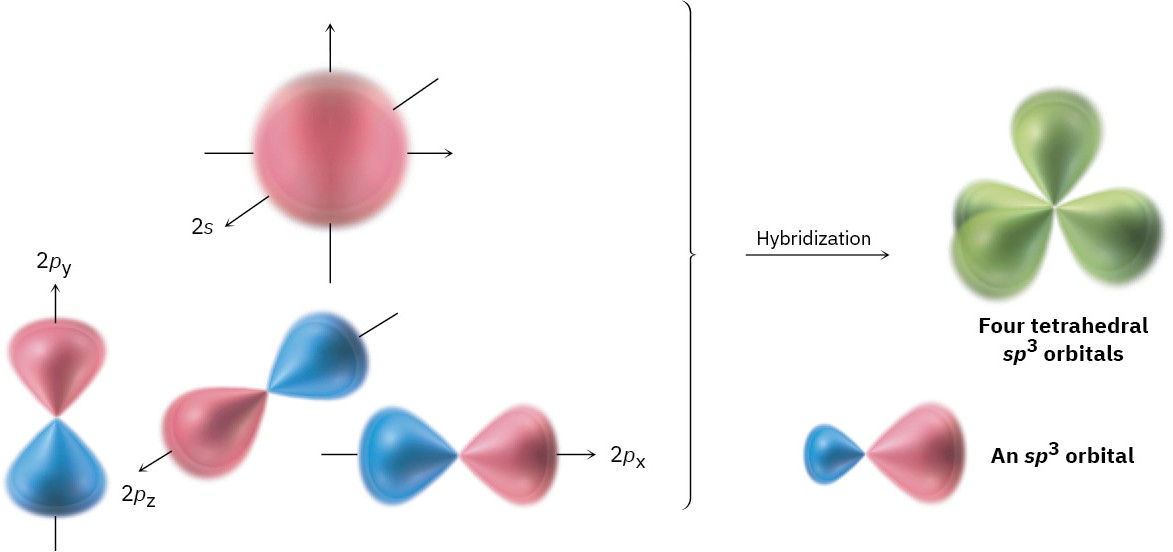1.6 sp3 Hybrid Orbitals and the Structure of Methane
The bonding in the hydrogen molecule is fairly straightforward, but the situation is more complicated in organic molecules with tetravalent carbon atoms. Take methane, CH4, for instance. As we’ve seen, carbon has four valence electrons (2s2 2p2) and forms four bonds. Because carbon uses two kinds of orbitals for bonding, 2s and 2p, we might expect methane to have two kinds of C–H bonds. In fact, though, all four C–H bonds in methane are identical and are spatially oriented toward the corners of a regular tetrahedron, as shown previously in Figure 1.8. How can we explain this?
An answer was provided in 1931 by Linus Pauling, who showed mathematically how an s orbital and three p orbitals on an atom can combine, or hybridize, to form four equivalent atomic orbitals with tetrahedral orientation. Shown in Figure 1.12, these tetrahedrally oriented orbitals are called sp3 hybrid orbitals. Note that the superscript 3 in the name sp3 tells how many of each type of atomic orbital combine to form the hybrid, not how many electrons occupy it.
 Figure 1.12 Four sp3 hybrid orbitals, oriented toward the corners of a regular tetrahedron, are formed by the combination of an s orbital and three p orbitals (red/blue). The sp3 hybrids have two lobes and are unsymmetrical about the nucleus, giving them a directionality and allowing them to form strong bonds to other atoms.
Figure 1.12 Four sp3 hybrid orbitals, oriented toward the corners of a regular tetrahedron, are formed by the combination of an s orbital and three p orbitals (red/blue). The sp3 hybrids have two lobes and are unsymmetrical about the nucleus, giving them a directionality and allowing them to form strong bonds to other atoms.
The concept of hybridization explains how carbon forms four equivalent tetrahedral bonds but not why it does so. The shape of the hybrid orbital suggests the answer to why. When an s orbital hybridizes with three p orbitals, the resultant sp3 hybrid orbitals are unsymmetrical about the nucleus. One of the two lobes is larger than the other and can therefore overlap more effectively with an orbital from another atom to form a bond. As a result, sp3 hybrid orbitals form stronger bonds than do unhybridized s or p orbitals.
The asymmetry of sp3 orbitals arises because, as noted previously, the two lobes of a p orbital have different algebraic signs, + and –, in the wave function. Thus, when a p orbital hybridizes with an s orbital, the positive p lobe adds to the s orbital but the negative p lobe subtracts from the s orbital. The resultant hybrid orbital is therefore unsymmetrical about the nucleus and is strongly oriented in one direction.
When each of the four identical sp3 hybrid orbitals of a carbon atom overlaps with the 1s orbital of a hydrogen atom, four identical C–H bonds are formed and methane results. Each C–H bond in methane has a strength of 439 kJ/mol (105 kcal/mol) and a length of 109 pm. Because the four bonds have a specific geometry, we also can define a property called the bond angle. The angle formed by each H–C–H is 109.5°, the so-called tetrahedral angle. Methane thus has the structure shown in Figure 1.13.
 Figure 1.13 The structure of methane, showing its 109.5° bond angles.
Figure 1.13 The structure of methane, showing its 109.5° bond angles.

